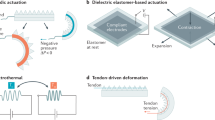Abstract
Biological systems in nature went through long evolution process that led to highly effective and efficient systems with excellent performance. Biomimetics is an interdisciplinary scientific research focuses on making nature as new sources of inspiration to study, analyze and design of creative and efficient engineering systems supported by innovative technologies. Smart materials are the foundation supporting the development of creative bioinspiration. Wide ranges of biologically inspired systems have been developed. However, engineering such as biomimetic intelligent creatures was hampered by physical and technological constraints, and it is still a challenge. Actuators are essential elements within mechatronical systems due to their important role in motion control systems and hence there is a need to develop new trend of actuators that can be inspired from biological actuation systems in nature associated with different levels of control. Making intelligent creatures that are actuated by biologically inspired modern actuators and artificial muscles would create new reality with great potentials. This paper provides the concept of biomimetic as an interdisciplinary field, discusses the enabling technologies, and presents the main development and bioinspired and emerging actuator technologies.
Similar content being viewed by others
Explore related subjects
Discover the latest articles, news and stories from top researchers in related subjects.References
Bar-Cohen Y (2003) Biologically inspired intelligent robotics. In: Proceedings of the SPIE Smart Structures Conference, Paper 5051-02
Habib MK (2011) Biomimetics: innovations and robotics. Int J Mechatron Manuf Systems 4(2):113–134
Habib MK (2007) Controlled biological and biomimetic systems for landmine detection. J Biosensors Bioelect 23:1–18
Liu GL, Habib MK, Watanabe K, Izumi K (2008) Central pattern generators based on Matsuoka oscillators for the locomotion of biped robots. J Artif Life Robot 12(1-2):264–269
Habib MK, Watanabe K, Izumi K (2009) Biped locomotion using CPG with sensory interaction. In: IEEE International Symposium on Industrial Electronics (IEEE ISIE’ 2009), Seoul, Korea, pp 1452–1457
Paulson LD (2004) Biomimetic robots. In: IEEE Computer, pp 48–53
Habib MK, Watanabe K, Izumi K (2007) Biomimetics intelligent robots and biological inspiration. In: International Conference on Control, Instrumentation and Mechatronics ‘CIM 2007’, Johor-Malaysia, pp 824–832
Dennis RG, Hugh Herr H (2005) Engineered muscle actuators: cells and tissues. In: Bar-Cohen (ed) Biomimetics: biologically inspired technologies, CRC Publisher, Boca Raton, pp 243–266
Popovic D, Sinkjaer T (2000) Control of movement for the physically disabled, Springer, Berlin
Dickinson MH, Farley CT, Full RJ, Koehl MAR, Kram R, Lehman S (2000) How animals move: an integrative view. Science 288:100–106
Clark E, Cham JG, Bailey SA, Froehlich EM, Nahata PK, Full RJ, Cutkosky MR (2001) Biomimetic design and fabrication of a hexapedal running robot. In: Proceedings of IEEE ICRA’ 2001, vol 4, pp 3643–3649
Pelrine R, Kornbluh R, Pei Q, Stanford S, Oh S, Eckerle J, Full R, Rosenthal Ma, Meijer K (2002) Dielectric elastomer artificial muscle actuators: toward biomimetic motion. In: SPIE Conference Proceedings, Smart structures and materials, vol 4695, pp 126–137
Ashley S (2003) Artificial muscles, Scientific American, USA, pp 52–59
Anderson AM, Streitlien K, Barrett DS, Triantafyllou MS (1998) Oscillating foils of high propulsive efficiency. J Fluid Mech 360:41–72
Unver, Uneri A, Aydemir A, Sitti M Geckobot: a Gecko inspired climbing robot using dry adhesives. In: Proceedings of the IEEE ICRA’ 2006, pp 2329–2335
Funakubo H (ed) (1987) Shape memory alloys. Gordon and Breach, New York
Hunter IW, Lafontaine S, Hollerbach JM, Hunter PJ (1991) Fast reversible NiTi fibers for use in microrobotics. Proc IEEE Micro Electro Mech Systems 2:166–170
Ikuta K (1990) Micro/miniature shape memory alloy actuator. Proc IEEE Micro Electro Mech Systems 3:2156–2161
Kubow TM, Full RJ (1999) The role of the mechanical system in control: a hypothesis of self-stabilization in hexapedal runners. Philos Trans Royal Soc Lond Ser B-Biol Sci 354(1385):849–861
Barisci JN, Spinks GM, Wallace CC, Madden JD, Baughman RH (2003) Increased actuation rate of electromechanical carbon nanotube actuators using potential pulses with resistance compensation. Smart Mater Struct 12(4):549–555
Gu G, Schmid M, Chiu P-W, Minett A, Fraysee J, Kim G-T, Roth S, Kozlov M, Munoz E, Baughman R (2003) V2O5 nanofibre sheet actuators. Nat Mater 2:316–319
Author information
Authors and Affiliations
Corresponding author
About this article
Cite this article
Habib, M.K., Watanabe, K. & Nagata, F. Bioinspiration and emerging actuator technologies. Artif Life Robotics 17, 191–196 (2012). https://doi.org/10.1007/s10015-012-0037-1
Received:
Accepted:
Published:
Issue Date:
DOI: https://doi.org/10.1007/s10015-012-0037-1




